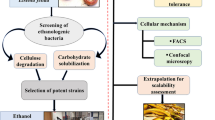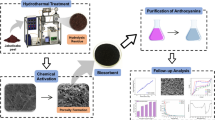Abstract
The palm oil industry has contributed substantially to environmental pollution due to the large volume of oil extraction by-products known as palm oil mill effluents (POME). Compared to several industrial effluents, POME is about 100 times more contaminated in terms of biochemical and chemical oxygen demand. Aerobic granular sludge technology is considered a more effective method for treating POME than traditional activated sludge systems. Nonetheless, the lengthy start-up phase of the granulation process is a significant disadvantage of this method. In this study, eco-eco-enzymes, a multifunctional liquid with high enzymatic activity, was tested to potentially accelerate the initial growth of granules. The study utilized a 5-set of 1-L bioreactors operated simultaneously, and samples were taken every 5 h for granulation and removal performance analysis. The results showed that the Spinach eco-enzyme had the highest potential to enhance initial granulation, with the highest surface hydrophobicity (52.6%), aggregation (80.7%), and settling performance (54.03 mL/g SS SVI) compared to banana, orange, and mango. Additionally, the Spinach eco-enzyme was the most efficient in removing total phosphorus, total ammonia nitrogen, and chemical oxygen demand (COD), with an 80%, 91.4%, and 70.4% respectively. These findings suggest that eco-enzymes, particularly the Spinach eco-enzyme, have the potential to act as a secondary treatment for treating POME with excellent initial granulation performance compared to banana, orange and mango eco-enzyme.













Similar content being viewed by others
Data availability
The data generated or analyzed during this study are included in this published article. Kindly contact the corresponding author for the provision of the data set used in this paper.
References
Soo PL, Bashir MJK, Wong LP (2022) Recent advancements in the treatment of palm oil mill effluent (POME) using anaerobic biofilm reactors: challenges and future perspectives. J Environ Manage 320:115750. https://doi.org/10.1016/j.jenvman.2022.115750
Ghosh S, Chakraborty S (2021) Aerobic granulation of single strain oil degraders: Salt tolerance enhancing organics and nitrogen removal from high-strength refinery wastewater. J Water Process Eng 42:102104. https://doi.org/10.1016/j.jwpe.2021.102104
Omoregie AI, Muda K, Rahman MR et al (2023) Impact of palm oil mill effluent as an economic medium for soil fixation via microbially induced carbonate precipitation. Biomass Convers Biorefin 1:1–33. https://doi.org/10.1007/s13399-023-03889-4
Rakhmania KH, Yuzir MA et al (2022) Electrochemical oxidation of palm oil mill effluent using platinum as anode: Optimization using response surface methodology. Environ Res 214:113993. https://doi.org/10.1016/j.envres.2022.113993
Ratnasari A, Syafiuddin A, Boopathy R et al (2022) Advances in pretreatment technology for handling the palm oil mill effluent: Challenges and prospects. Bioresour Technol 344:126239. https://doi.org/10.1016/j.biortech.2021.126239
Ronan E, Aqeel H, Wolfaardt GM, Liss SN (2021) Recent advancements in the biological treatment of high strength ammonia wastewater. World J Microbiol Biotechnol 37:1–17. https://doi.org/10.1007/s11274-021-03124-0
Harun H, Anuar AN, Halim MHA et al (2020) Granulation and biodegradation by microbial species in granular sequencing batch reactor for soy sauce wastewater treatment. In: alorisation of agro- industrial residues–volume I: Biological approaches, pp 287–308. https://doi.org/10.1007/978-3-030-39137-9_14
Lin H, Ma R, Hu Y et al (2020) Reviewing bottlenecks in aerobic granular sludge technology: Slow granulation and low granular stability. Environ Pollut 263:114638. https://doi.org/10.1016/j.envpol.2020.114638
Carrera P, Casero-Díaz T, Castro-Barros CM et al (2021) Features of aerobic granular sludge formation treating fluctuating industrial saline wastewater at pilot scale. J Environ Manage 296:113135. https://doi.org/10.1016/j.jenvman.2021.113135
Dominic D, Baidurah S (2022) Recent Developments in Biological Processing Technology for Palm Oil Mill Effluent Treatment—A Review. Biology 11:525. https://doi.org/10.3390/biology11040525
Mohammad S, Baidurah S, Kobayashi T et al (2021) Palm oil mill effluent treatment processes—A review. Processes 9:739. https://doi.org/10.3390/pr9050739
Peng T, Wang Y, Wang J et al (2022) Effect of different forms and components of EPS on sludge aggregation during granulation process of aerobic granular sludge. Chemosphere 303:135116. https://doi.org/10.1016/j.chemosphere.2022.135116
Basri HF, Anuar AN, Halim MHA et al (2023) Aerobic granular sludge development using diatomite for low-strength wastewater treatment. Environ Monit Assess 195:420. https://doi.org/10.1007/s10661-023-11028-9
Xu P, Xie Z, Shi L et al (2022) Distinct responses of aerobic granular sludge sequencing batch reactors to nitrogen and phosphorus deficient conditions. Sci Total Environ 834:155369. https://doi.org/10.1016/j.scitotenv.2022.155369
Ali NSA, Muda K, Mohd Amin MF et al (2021) Initialization, enhancement and mechanisms of aerobic granulation in wastewater treatment. Sep Purif Technol 260:118220. https://doi.org/10.1016/j.seppur.2020.118220
Omar AH, Muda K, Omoregie AI et al (2023) Enhancement of biogranules development using magnetized powder activated carbon. Biodegradation 34:235–252. https://doi.org/10.1007/s10532-023-10016-7
Zahra SA, Abdullah N, Iwamoto K et al (2022) Alginate-like exopolysaccharides in aerobic granular sludge: A review. Mater Today Proc 65:3046–3053. https://doi.org/10.1016/j.matpr.2022.04.032
Wang H, Guo L, Ren X et al (2022) Enhanced aerobic granular sludge by static magnetic field to treat saline wastewater via simultaneous partial nitrification and denitrification (SPND) process. Bioresour Technol 350:126891. https://doi.org/10.1016/j.biortech.2022.126891
Han X, Jin Y, Yu J (2022) Rapid formation of aerobic granular sludge by bioaugmentation technology: A review. Chem Eng J 437:134971. https://doi.org/10.1016/j.cej.2022.134971
Sarvajith M, Nancharaiah YV (2022) Enhancing biological nitrogen and phosphorus removal performance in aerobic granular sludge sequencing batch reactors by activated carbon particles. J Environ Manage 303:114134. https://doi.org/10.1016/j.jenvman.2021.114134
Benny N, Shams R, Dash KK et al (2023) Recent trends in utilization of citrus fruits in production of eco-enzyme. J Agric Food Res 13:100657. https://doi.org/10.1016/j.jafr.2023.100657
Le OTH, Tran LN, Doan VT et al (2020) mucilage extracted from dragon fruit peel (hylocereus undatus) as flocculant for treatment of dye wastewater by coagulation and flocculation process. Int J Polym Sci 2020:7468343. https://doi.org/10.1155/2020/7468343
Wen LC, Ling RLZ, Teo S-S (2021) Effective microorganisms in producing eco-enzyme from food waste for wastewater treatment. Applied Microbiology : Theory & Technology:28–36. https://doi.org/10.37256/amtt.212021726
Sambaraju S, Sree Lakshmi V (2020) Eco-friendly treatment of dairy wastewater using garbage enzyme. Mater Today Proc 33:650–653. https://doi.org/10.1016/j.matpr.2020.05.719
Patel BS, Solanki BR, Mankad AU (2021) Effect of eco-enzymes prepared from selected organic waste on domestic waste water treatment. World J Adv Res Rev 10:323–333. https://doi.org/10.30574/wjarr.2021.10.1.0159
APHA (2012) Standard methods for the examination of water and wastewater. American Public Health Association, Washington
Galintin O, Rasit N, Hamzah S (2021) Production and characterization of eco enzyme produced from fruit and vegetable wastes and its influence on the aquaculture sludge. Biointerface Res Appl Chem 11:10205–10214. https://doi.org/10.33263/BRIAC113.1020510214
Cui F, Kim M, Park C et al (2021) Application of principal component analysis (PCA) to the assessment of parameter correlations in the partial-nitrification process using aerobic granular sludge. J Environ Manage 288:112408. https://doi.org/10.1016/j.jenvman.2021.112408
Cheng YW, Chong CC, Lam MK et al (2021) Holistic process evaluation of non-conventional palm oil mill effluent (POME) treatment technologies: A conceptual and comparative review. J Hazard Mater 409:124964. https://doi.org/10.1016/j.jhazmat.2020.124964
Kietkwanboot A, Chaiprapat S, Müller R, Suttinun O (2022) Dephenolization of palm oil mill effluent by oil palm fiber-immobilized Trametes hirsuta AK04 in temporary immersion bioreactor for the enhancement of biogas production. Environ Sci Pollut Res 29:7559–7572. https://doi.org/10.1007/s11356-021-16199-x
Nurdin N, Kosasih D, Karyaningsih I et al (2022) Utilization of eco enzyme for wastewater treatment (greywater) at Kuningan University. https://doi.org/10.4108/eai.2-12-2021.2320222
Arun C, Sivashanmugam P (2015) Investigation of biocatalytic potential of garbage enzyme and its influence on stabilization of industrial waste activated sludge. Process Saf Environ Prot 94:471–478. https://doi.org/10.1016/j.psep.2014.10.008
Zaidi NS, Muda K, Loan LW et al (2019) Potential of fruit peels in becoming natural coagulant for water treatment. Int J Integ Eng 11:140–150. https://doi.org/10.30880/ijie.2019.11.01.017
Wang X, Li J, Zhang X et al (2021) Impact of hydraulic retention time on swine wastewater treatment by aerobic granular sludge sequencing batch reactor. Environ Sci Pollut Res 28:5927–5937. https://doi.org/10.1007/s11356-020-10922-w
Zhi Ling RL, Kong LK, Lim LH et al (2023) Identification of microorganisms from fermented biowaste and the potential for wastewater treatment. Environ Res 218:115013. https://doi.org/10.1016/j.envres.2022.115013
Regina L, Teo S sen (2019) Designing prototype micro-technology for sustainable management of natural water resource in Batu Pahat River, Johor. Int J Mar Biol Res 4:1–15
Zaidi NS, Sohaili J, Muda K et al (2021) Effect of magnetic field on biomass properties and their role in biodegradation under condition of low dissolved oxygen. Appl Water Sci 11:1–12. https://doi.org/10.1007/s13201-021-01439-9
Hashem AH, Saied E, Hasanin MS (2020) Green and ecofriendly bio-removal of methylene blue dye from aqueous solution using biologically activated banana peel waste. Sustain Chem Pharm 18:100333. https://doi.org/10.1016/j.scp.2020.100333
Basri HF, Anuar AN, Halim MHA (2020) Pilot scale study on characterization and performance of aerobic granular sludge to treat domestic wastewater. Malays J Fundam Appl Sci 16:38–43. https://doi.org/10.11113/mjfas.v16n1.1462
Wikaningrum T, Hakiki R, Astuti MP et al (2022) The Eco Enzyme Application on Industrial Waste Activated Sludge Degradation. Indones J Urban and Environ Technol:115–133. https://doi.org/10.25105/urbanenvirotech.v5i2.13535
Nazim F, Meera V (2013) Treatment of synthetic greywater using 5% and 10% garbage enzyme solution. Bonfring Int J Ind Eng Manage Sci 3:111–117. https://doi.org/10.9756/BIJIEMS.4733
Joseph A, Joji JG, Prince NM et al (2021) Domestic wastewater treatment using garbage enzyme. SSRN Electron J. https://doi.org/10.2139/ssrn.3794572
Rani A, Negi S, Hussain A, Kumar S (2020) Treatment of urban municipal landfill leachate utilizing garbage enzyme. Bioresour Technol 297:122437. https://doi.org/10.1016/j.biortech.2019.122437
Liu X, Pei Q, Han H et al (2022) Functional analysis of extracellular polymeric substances (EPS) during the granulation of aerobic sludge: Relationship among EPS, granulation and nutrients removal. Environ Res 208:112692. https://doi.org/10.1016/j.envres.2022.112692
Nancharaiah YV, Kiran Kumar Reddy G (2018) Aerobic granular sludge technology: Mechanisms of granulation and biotechnological applications. Bioresour Technol 247:1128–1143. https://doi.org/10.1016/j.biortech.2017.09.131
Funding
The authors would like to acknowledge the financial support from Universiti Teknologi Malaysia for the UTM Encouragement Research Grant through research grant number: Q.J130000.3851.20J61.
Author information
Authors and Affiliations
Contributions
All authors contributed to manuscript revision and read and approved the submitted version. Hazlami Fikri Basri: conceptualization data accusation, methodology, software analysis, first to final draft writing; Armstrong Ighodalo Omoregie, Khalida Muda, and Yong Ee Ling: validation, review, and editing and software analysis.
Corresponding author
Ethics declarations
Conflict of interest
The authors declare no competing interests.
Additional information
Publisher's note
Springer Nature remains neutral with regard to jurisdictional claims in published maps and institutional affiliations.
Rights and permissions
Springer Nature or its licensor (e.g. a society or other partner) holds exclusive rights to this article under a publishing agreement with the author(s) or other rightsholder(s); author self-archiving of the accepted manuscript version of this article is solely governed by the terms of such publishing agreement and applicable law.
About this article
Cite this article
Basri, H.F., Muda, K., Omoregie, A.I. et al. Enhancing palm oil mill effluent treatment through initial granulation of fruit and vegetable eco-enzymes. Biomass Conv. Bioref. (2023). https://doi.org/10.1007/s13399-023-04668-x
Received:
Revised:
Accepted:
Published:
DOI: https://doi.org/10.1007/s13399-023-04668-x




